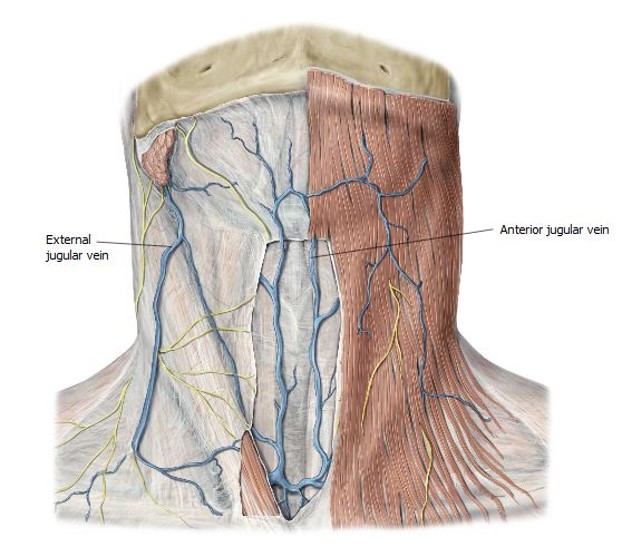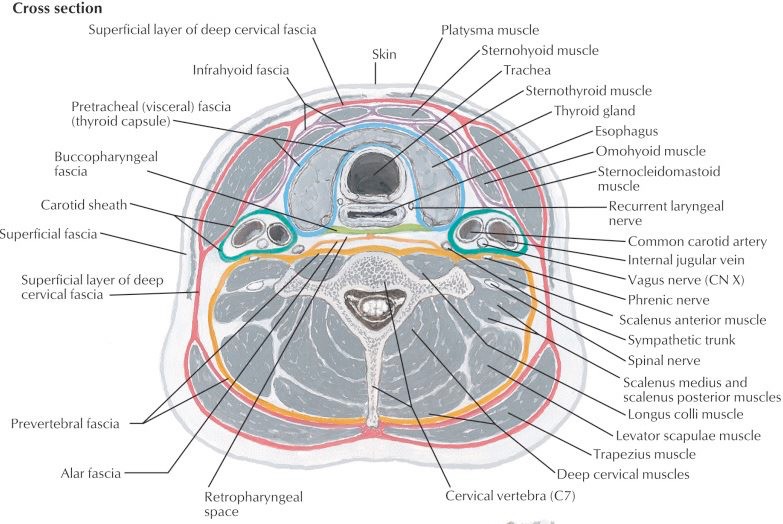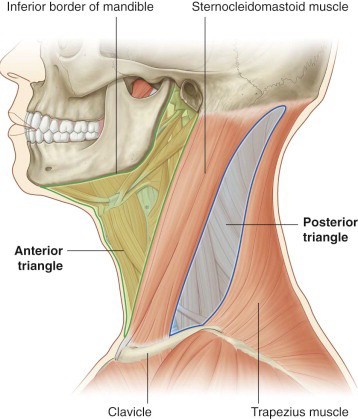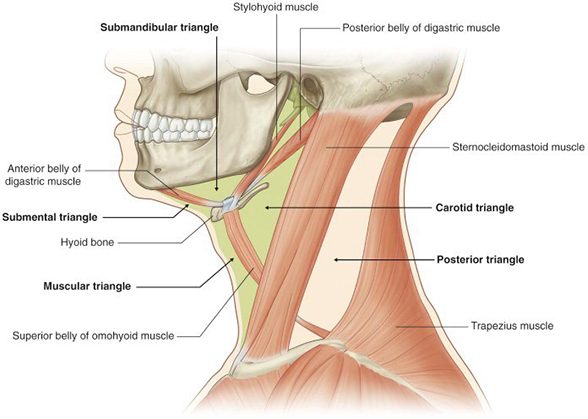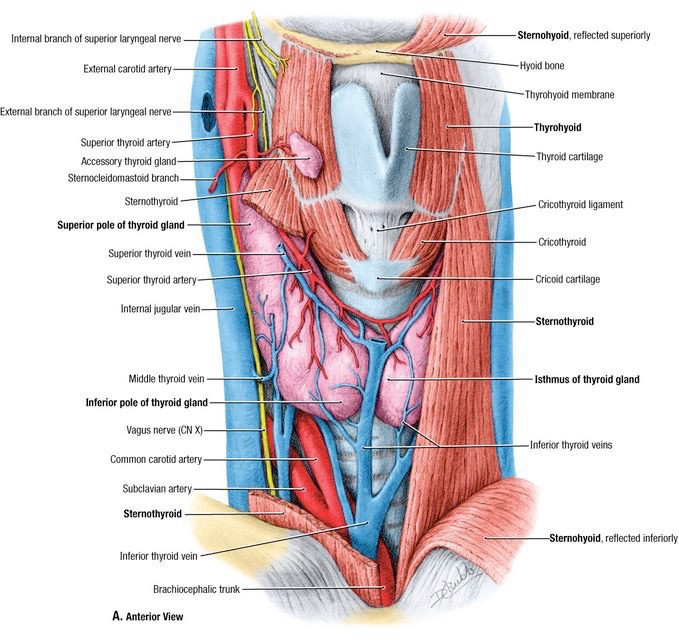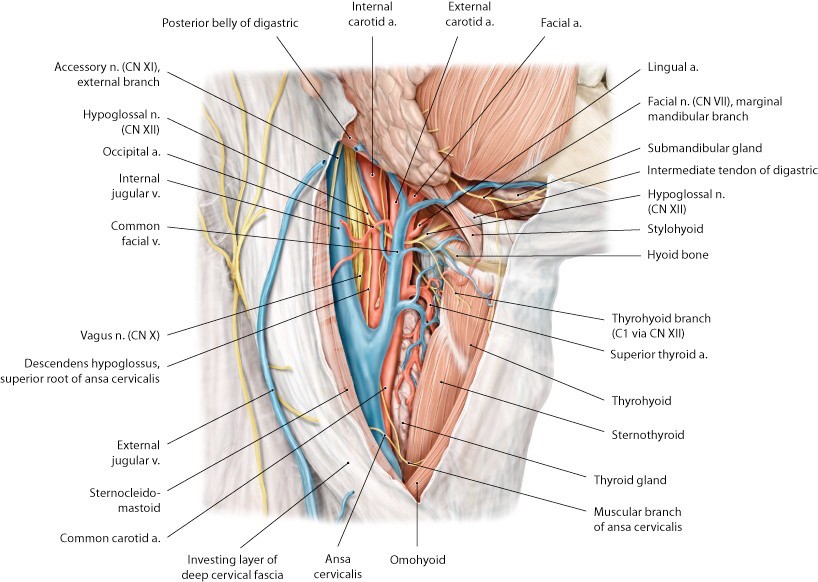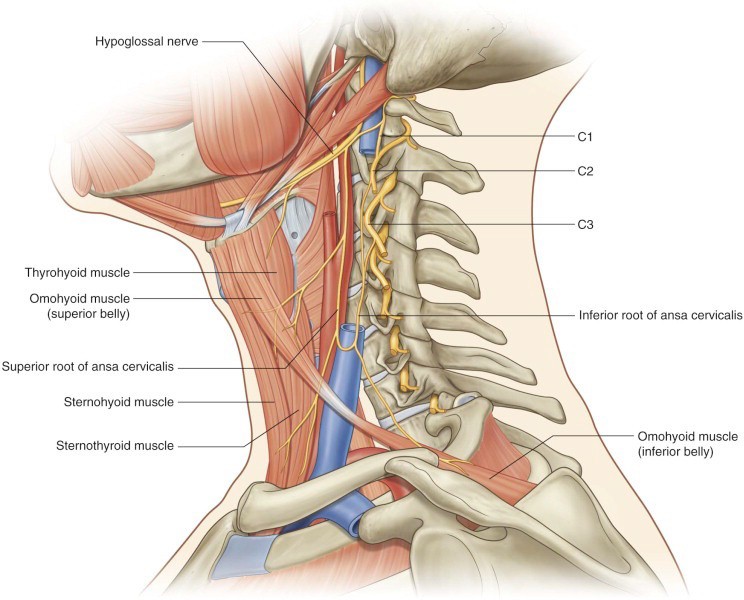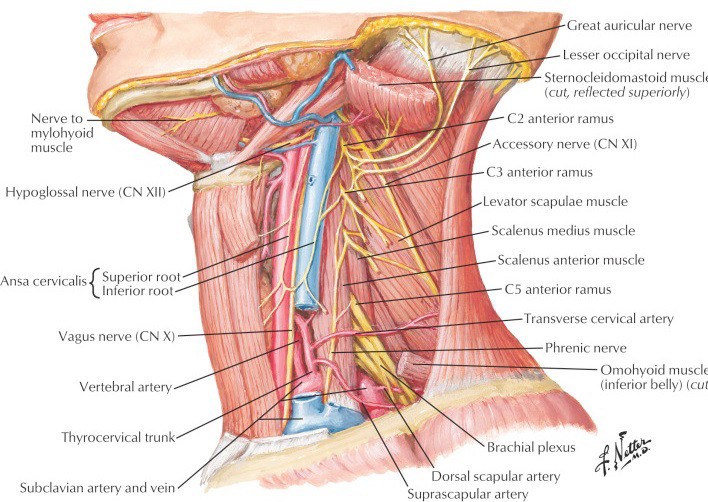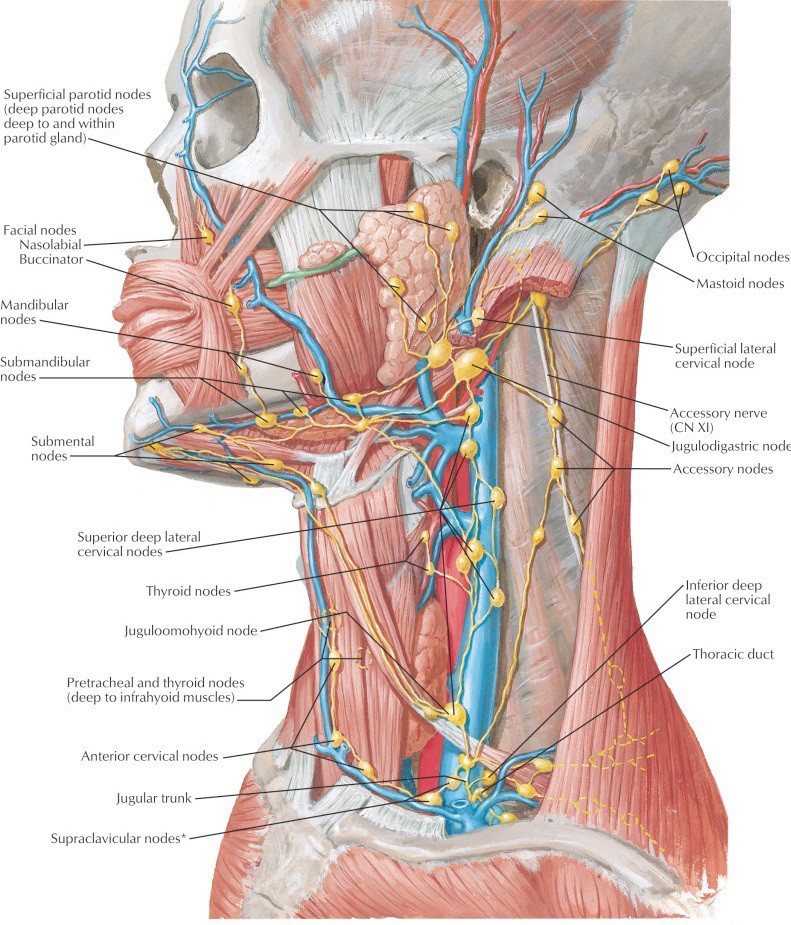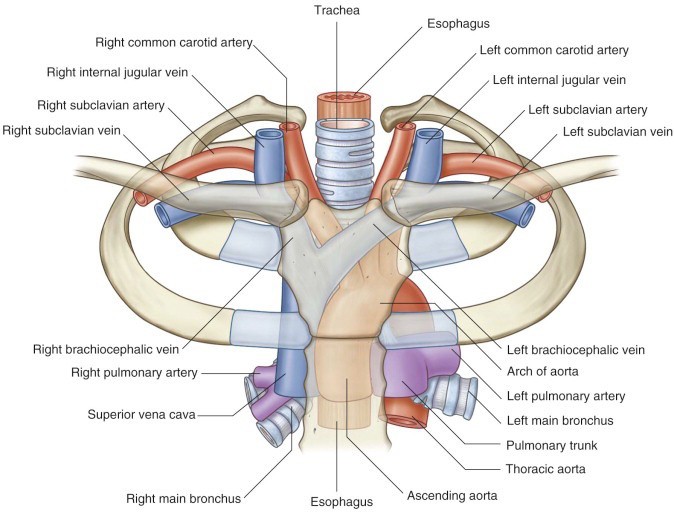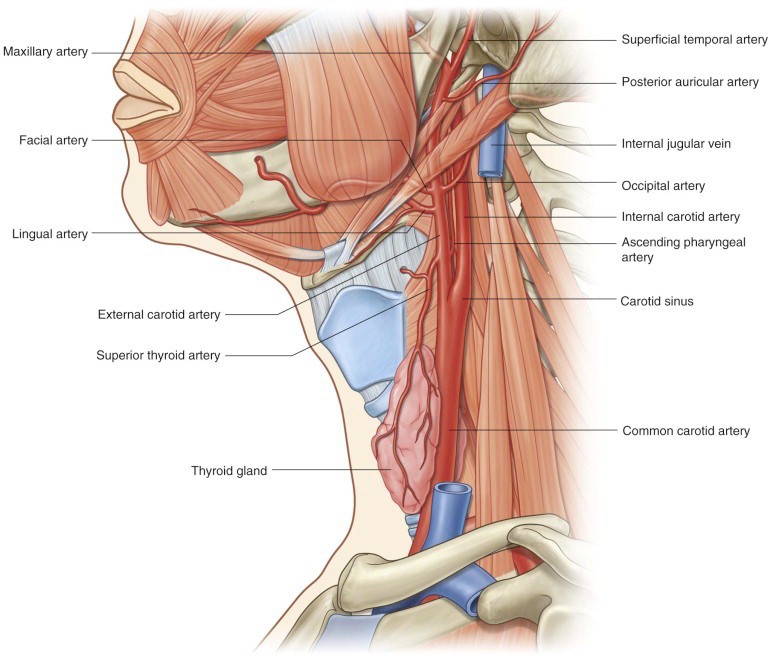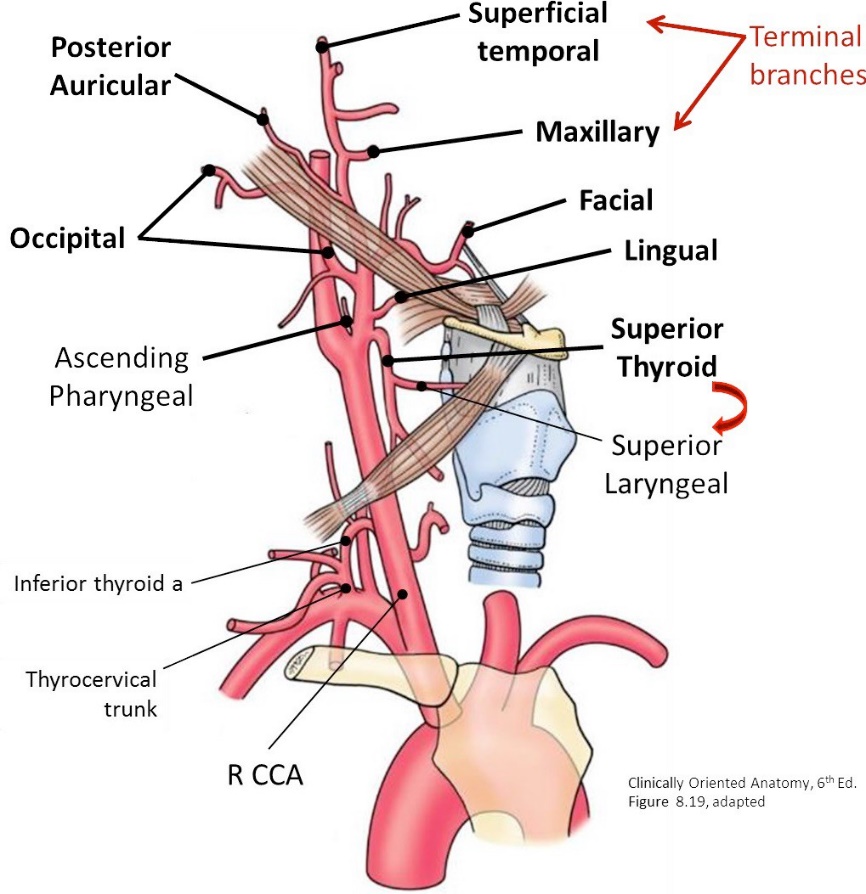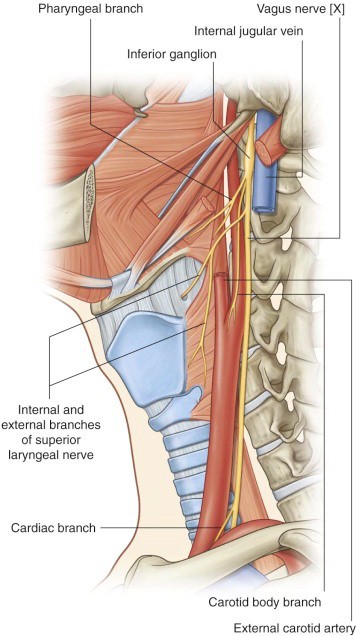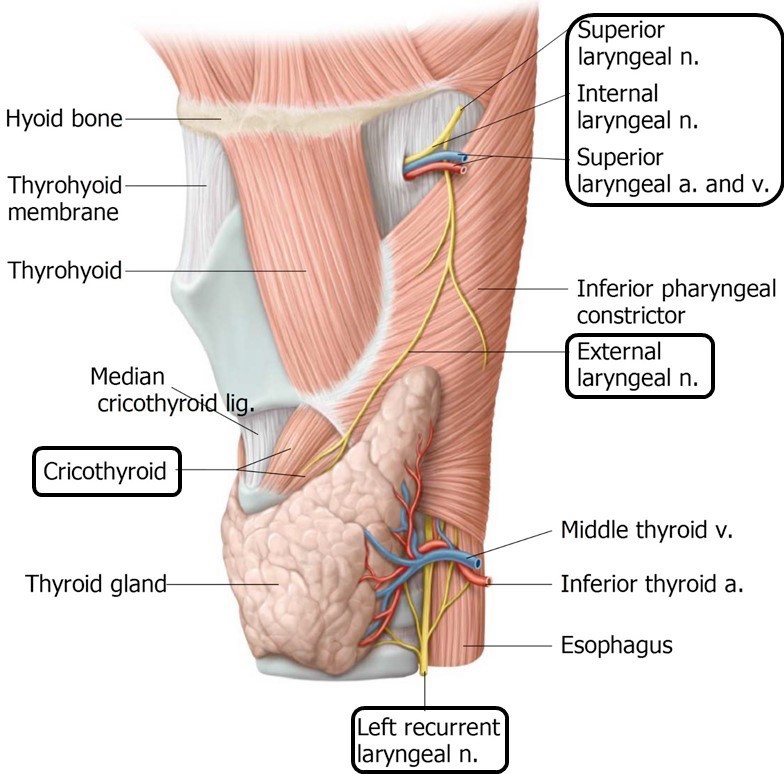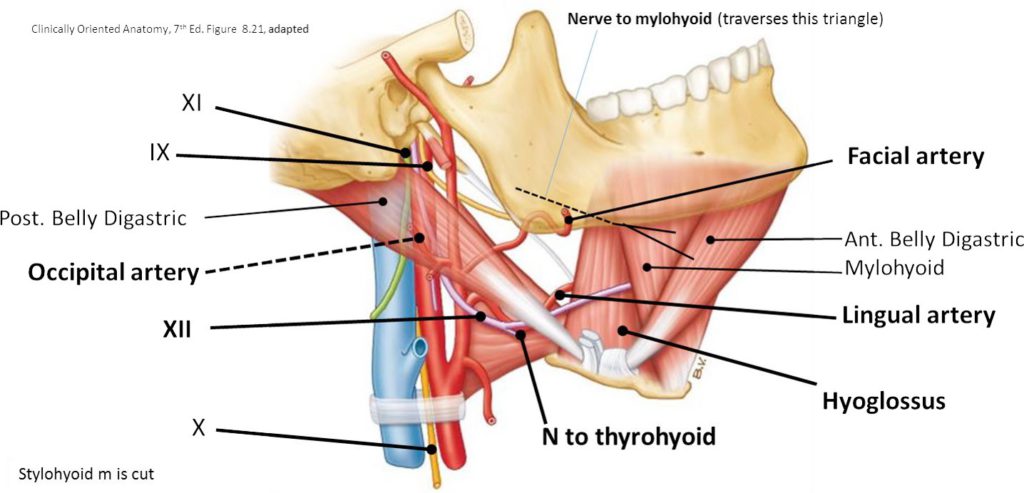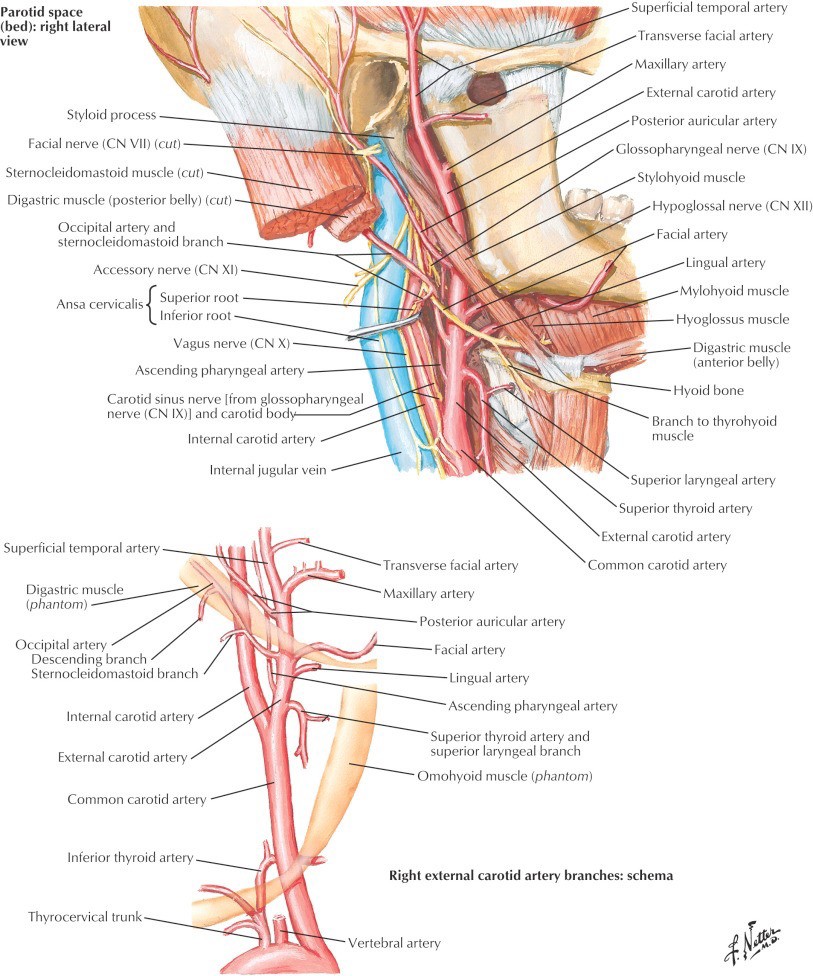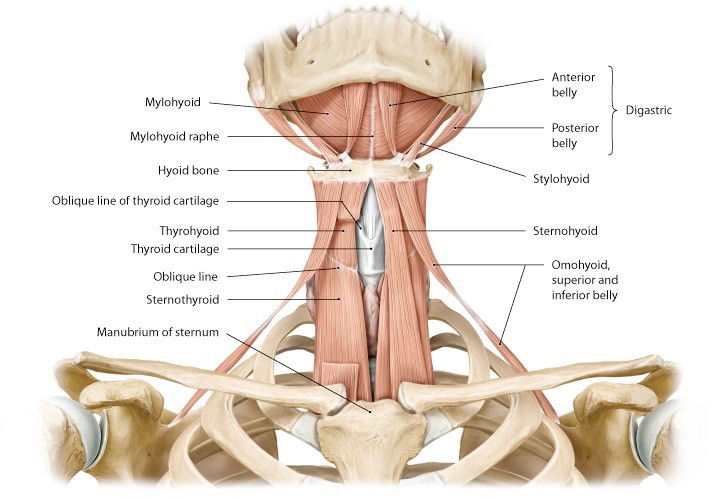1Review the bony anatomy of the cervical vertebrae and the hyoid bone.
2Clean the muscles and landmarks that define the triangles of the neck.
3Dissect the contents of the anterior triangle focusing on these subtriangles: carotid, muscular, and submental.
4Study prosected specimens.
Cervical Vertebrae and Hyoid Bone
Atlas (C-1)
■Lateral masses—with superior and inferior articular surfaces
■Anterior and posterior arches
Axis (C-2)
■Body
■Dens
■Vertebral arch (with pedicles and laminae)
C-3 through C-7
■Body
■Vertebral arch
■Pedicle
■Lamina
■•Note that the spinous processes are bifid.
General Features of Cervical Vertebrae
■All cervical vertebrae have a transverse foramen in their transverse processes. The vertebral arteries pass through the foramina of C-1 to C-6 but miss the foramina of C-7.
■Note the intervertebral foramina formed when two adjacent vertebrae articulate these transmit cervical spinal nerves above their corresponding vertebrae (i.e., C-2 spinal nerve exits above C-2 vertebra).
Between which bones does the C-1 spinal nerve exit?
Hyoid Bone
■Body of hyoid bone
■Greater and lesser horns
■The hyoid is in the anterior neck at the level of C-3.
■The hyoid is unique in that does not articulate with any other bone.
■Supra-hyoid muscles attach the hyoid to the mandible and styloid processes.
■Infra-hyoid muscles (strap muscles) attach the hyoid to the thyroid cartilage, sternum, and scapulae.
Cervical Fascia
In a previous lab (face and superficial neck), the skin was reflected from the neck.
In the superficial fascia of the neck identify the following:
■Platysma muscle
■External jugular veins
■Anterior jugular veins
Reflect the platysma muscles.
Deep to the superficial fascia of the neck is the deep cervical fascia. It has these subparts:
■Investing fascia
■Pretracheal fascia
■Prevertebral fascia
■Carotid sheath
Chalk Talk
Draw a transverse section of the neck, and sketch in the three layers of deep cervical fascia: investing, pretracheal, and prevertebral. Include the infrahyoid part of the pretracheal fascia = it encloses the infrahyoid (strap) muscles. Also draw in the carotid sheath.
The investing fascia forms the roof of the triangles of the neck. It forms envelops around the sternocleidomastoid and trapezius muscles. It must be incised and cleaned in order to view the contents of the neck triangles.
Triangles of the Neck
Chalk Talk
Sketch and identify the boundaries of the anterior and posterior triangles. Then sketch and describe the boundaries of subtriangles in the neck: submandibular, submental, carotid, and muscular triangles.
Clean and reflect the sternocleidomastoid muscles.
Carefully clean the investing fascia from the surface of the sternocleidomastoid muscles and reflect the muscle on both sides superiorly, elevating the muscles toward the head.
Anterior Triangle
Locate and palpate the following:
Landmarks
Submental Triangle
Carotid Triangle
Define the boundaries of the carotid triangle.
Identify the carotid sheath within the carotid triangle and LIST ITS CONTENTS.
The carotid sheath is continuous with all three layers of the deep cervical fascia = investing, pretracheal, and prevertebral. Deep to the sheath is the sympathetic trunk (next lab).
Carefully probe and dissect the surface of the carotid sheaths.
Look for the ansa cervicalis, a motor nerve of the cervical plexus, shaped like a “loop” (superior root from C-1 and an inferior root from C-2,3).
Start out by probing just lateral to the internal jugular vein at the level of the carotid bifurcation to find the inferior root—gently pull it away from the vein and follow it inferiorly as it loops.
Open the carotid sheath with scissors, but try and keep the ansa cervicalis.
See if you can identify some deep cervical nodes (often on the surface of the vein) located near the omohyoid and digastric muscles.
One of the most prominent of the deep cervical nodes is located superiorly, adjacent to the angle of the mandible. This is the jugulo-digastric node, also known as the “tonsillar” node.
Note the complexity and variability of veins that drain into the internal jugular. Locate the common facial vein.
Carotid Arteries
What is the function of the carotid sinus? Which nerve carries visceral afferent signals from it?
Within the bifurcation (between ICA and ECA) is a small vascular structure = no bigger than a pin’s head. This is the carotid body.
What is the function of the carotid body? Which nerve carries visceral afferent signals from it?
Clean the posterior belly of the digastric and stylohyoid muscles.
Use the hyoid bone as a landmark to identify the tendon between the anterior and posterior bellies of the digastric muscles. Clean and trace the posterior digastric towards its attachment to the mastoid process.
The stylohyoid muscle runs from the styloid process to the hyoid bone. Note that the stylohyoid muscle splits around the tendon of the digastric muscle to attach to the hyoid bone.
What nerve innervates the posterior digastric and stylohyoid muscles? (Hint: the nerve exits the foramen located between the proximal attachment of these two muscles)
Clean the external carotid artery and its branches.
IDENTIFY as many branches of the external carotid in the neck as possible:
ONE side: reflect the stylohyoid and posterior digastric muscles.
On one side of the neck (preferable, on the same side as the deep dissection of the face where the parotid gland was removed), detach the muscles from the hyoid bone and reflect them. Now trace the external carotid artery up to the head to where the parotid gland used to be located.
Chalk Talk
Sketch the external carotid artery and its branches: three anterior branches, one medial branch, two posterior branches, and two terminal branches. Discuss the regions of the head and neck that receive blood supply from these arteries.
Vagus Nerves
Identify the vagus nerve by separating the common carotid artery and internal jugular vein at the level of the thyroid cartilage. Trace it inferiorly into the thorax.
Find the large superior laryngeal branch of the vagus. This comes off the vagus high, just below the skull. You won’t find the origin of this nerve, but you will see it heading toward the larynx.
The superior laryngeal nerve divides into a thin external branch (external laryngeal nerve) and a larger internal branch (internal laryngeal nerve).
The internal laryngeal nerve enters the larynx through the thyrohyoid membrane. Palpate the hyoid bone then move inferiorly to feel the soft thyrohyoid membrane. The superior laryngeal artery (a branch of the superior thyroid artery) accompanies the internal laryngeal nerve into the larynx.
Relationship: The external laryngeal nerve courses in tandem with the superior thyroid artery. Earn a gold star for the day by finding this thin nerve. It courses inferiorly to the cricothyroid muscle of the larynx.
What is the function of the internal and external laryngeal nerves?
(Hint: Think back to the respiratory block when you learned about the larynx; one branch is sensory and one is motor.)
Submandibular Triangle
Identify the boundaries of the submandibular triangle.
Why is this also known as the digastric triangle?
Identify the submandibular gland, anterior and posterior bellies of the digastric muscle, stylohyoid muscle, and facial artery and vein. The facial artery is very tortuous as it passes around the submandibular gland and over the mandible to the face.
Note any submandibular lymph nodes.
Locate and clean the hypoglossal nerve (CN XII).
Tip
Locate the posterior belly of the digastric and occipital artery as landmarks.
The lowest part of the nerve loops below the posterior belly of the digastric/stylohyoid muscles.
In almost every case, the hypoglossal nerve crosses the occipital artery—so look for this sure-fire relationship.
The hypoglossal continues above the hyoid bone into the base of the tongue.
What is the function of CN XII?
Nerve fibers from the ventral ramus of C-1 “hitch a ride” on the hypoglossal to get where they need to go = they drop off to form the superior root of the ansa cervicalis, as well as to innervate the thyrohyoid and geniohyoid muscles.
Finally, clean the deep surface of the reflected sternocleidomastoid muscles (SCM). Look for the flat, white, thick spinal accessory nerve entering the deep surface of the SCM.
Muscular Triangle
One side: Reflect the sternohyoid muscle on one side of the neck.
1Identify the sternothyroid and thyrohyoid muscles deep to the reflected sternohyoid.
2Now reflect the sternothyroid muscle to see the thyroid gland under it. The thryoid is surrounded by a capsule made of pretracheal fascia.
3 Locate the thyroid cartilage of the larynx, the cricoid cartilage, and the cricothyroid membrane. The cricothyroid membrane is the “soft spot” between the thyroid and cricoid cartilages of the larynx.
Clinical correlation
The cricothyroid membrane is the site of an “emergency airway” (cricothyrotomy).
In emergent situations (CICO = “cannot intubate, cannot oxygenate”), an emergency airway can be created via the cricothyroid membrane. Cricothyrotomy is performed by inserting a tube through an incision in the skin and cricothyroid membrane. This site is preferred because it is superficial, palpable, and usually without anatomic obstructions.
Checklist, Lab #28
Review your dissection and make sure you have identified each of the structures in the checklists that follow.
Note
Checklists for the cervical vertebrae and the hyoid bone are in the Osteology section of this lab guide.
Review boundaries of neck triangles and landmarks in the anterior neck
Anterior and posterior triangles
Submental, submandibular, carotid, and muscular triangles
Hyoid bone
Thyroid cartilage w/laryngeal prominence
Cricoid cartilage
Cricothyroid membrane
Trachea
Divisions of deep cervical fascia
Investing
Prevertebral
Pretracheal
Infrahyoid part of pretracheal fascia
Carotid sheath
Muscles
Sternocleidomastoid
Trapezius
Digastric (anterior and posterior bellies)
Stylohyoid
Mylohyoid
Omohyoid (superior and inferior bellies)
Sternohyoid
Sternothyroid
Thyrohyoid
Nerves
Ansa cervicalis
Phrenic nerve
Spinal accessory nerve (entering the deep surface of the SCM)
Hypoglossal nerve
Vagus
Superior laryngeal nerve (branch of vagus)—find the internal branch (internal laryngeal nerve) entering the larynx through the thyrohyoid membrane just below the hyoid bone
Vessels
Internal jugular vein
Subclavian artery and vein
Common carotid artery
Internal cartoid artery
External carotid artery
Carotid sinus and carotid body
Superior thyroid artery
Facial artery
Lingual artery
Occipital artery (wish list item—follow the hypoglossal nerve proximally—it crosses deep to the occipital artery)
Other
Deep cervical lymph nodes
Jugulodigastric node (a specially named deep cervical node)—the jugulodigastric node is the “tonsillar node.” Why?
